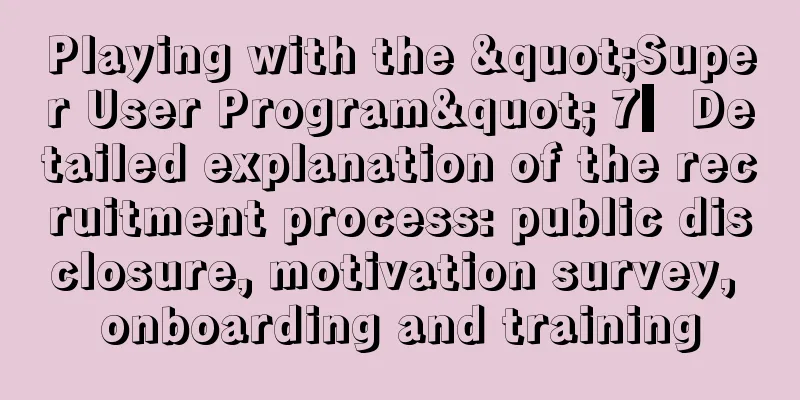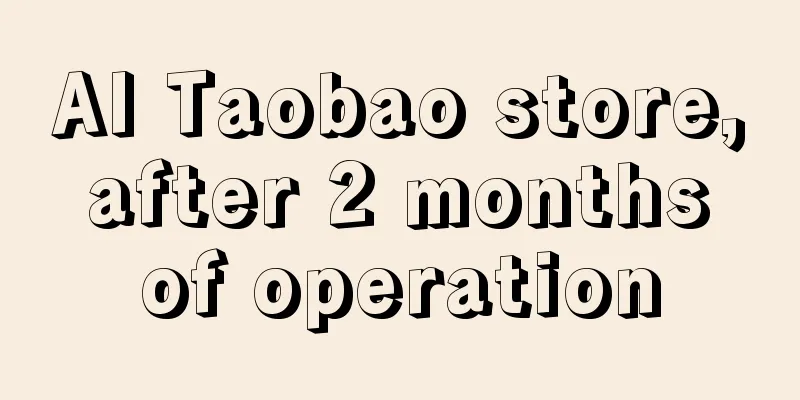Playing with the "Super User Program" 7▎Detailed explanation of the recruitment process: public disclosure, motivation survey, onboarding and training

In every community and brand, a group of leaders and opinion leaders emerge. They are not only more visible and have more say than other users, but also more active and effective in the community. An effective super user program can help you leverage the wisdom, passion, and skills of these top performers to benefit your community or brand. This series has twelve articles in total. The previous content: 1) Definition 2) Value 3) Crowd 4) Steps 5) Motivation 6) Recruitment. Today we will show Part 7: Recruitment Process. Once you have determined the criteria and methods for recruiting super users, you can start the recruitment process, which includes four key steps: publicizing the recruitment process and exit mechanism, filling out the application form (motivation survey), onboarding, and training. 1. Plan, clarify and publicize the recruitment process to ensure fairness and transparency. 2. Super user recruitment period and exit mechanism. 3. The key to the super user application form: understand the "motivation". 4. Tips for “onboarding” and welcoming new members 5. Training of new members. 1. Plan, clarify and publicize the recruitment process to ensure fairness and transparency throughout the processWhen recruiting, be careful not to rush for quick results. Rushing into a recruitment effort without adequate preparation and forethought often results in a failure to find the most suitable candidates. This not only limits the potential of the program, but can also waste valuable resources and even lead to a loss of trust in the project from superiors and partners. Take Google's "Top Contributor" program as an example. Early members are usually invited to join after they have made long-term contributions. However, in a project adjustment, Google realized that by promoting the project in the community earlier (for example, through email, bulletin boards, etc.), it can significantly expand the selection range of potential active members. This shows that timely communication and external publicity are crucial in the recruitment process. By communicating information to community members in advance, you can not only attract more potential candidates, but also provide them with opportunities to participate. This practice not only expands the recruitment scope, but also builds trust and attracts more valuable talents to join the project. To achieve this, just follow three simple steps: Step 1: Determine the “Standard List” for Super MembersCreate a specific “list of criteria” for each role (or group) you need to recruit for. Knowing these criteria at the outset will help you find a better fit. Case 1: Salesforce does an excellent job of identifying potential MVPs. Salesforce MVPs are outstanding individuals in the Salesforce community who are recognized for their leadership, knowledge, and sustained contributions to the community. These individuals represent the spirit of the community and what it means to be a part of it.
Step 2: Establish application and contract signing processOnce you have determined the criteria for the people you need, you can start the recruiting and contracting process. Let’s look at how some successful programs have implemented this process:
The selection of recruitment methods should be determined by program goals, the primary platform for member activity, the behaviors that need to be developed, and the available program management resources. Step 3: Formalize the plan through a “public document”Once you’ve determined your recruitment method, the next step is to formalize your plan through a public document. While you may not want to make all the details public to prevent someone from abusing the system, potential members need to have a clear understanding of how to apply and where to apply. In addition to brand communities, you can also look for super users on a wider scale based on the goals you set. For example, for Magento, they will consider exploring potential program members through StackExchange and other relevant communities. Channels explored include:
Through these diverse channels, we will be able to attract outstanding candidates more effectively and promote the successful implementation of the plan. II. Clarify the term of office and exit mechanism of membersA successful program requires not only clear guidelines and incentives, but also fixed membership terms, meaning that members have the opportunity to opt out if their interests or commitments change. From a brand perspective, limited-term roles can encourage members who are underperforming or not a good fit for the team to automatically exit. At the same time, limiting the term of ambassadors or super users creates valuable opportunities for new members to join, thus ensuring the continued effectiveness of the program.
Based on your available resources, decide which recruitment cycle will work best for your program to ensure it operates efficiently. 3. Super User Application Form and Key Element “Motivation”In the application form filled out when registering with the community, it is recommended to collect the minimum information to reduce the difficulty of conversion. However, in the "Super User Program", as much information as possible should be collected during the first contact, especially about their "motivation". Gaining insight into this information at the outset of your program will provide you with critical information as you refine and expand your program over time. 1. Understanding the motivations of super users is crucialAt this stage, you can ask applicants questions such as:
This information will help you gain insight into their motivations and, in turn, discover how to motivate them and better utilize their skills. Of course, it is crucial to identify their motivations for participating:
By understanding their motivations, you can better understand their goals and expectations for participating in the program. This will enable you to provide corresponding rewards and incentives for different motivations, thereby meeting their needs and increasing their enthusiasm and commitment. Whether they’re seeking self-development, enhanced career opportunities, or access to unique benefits, a more engaging and meaningful superuser program can be crafted based on their motivations. 2. Only by asking questions skillfully can you get real answers!Before you ask, think about this: Are people willing to share honestly what they really think? Will they admit that they are seeking social status or influence in your organization? Rather than casually asking people what they want, craft more specific questions that elicit more genuine responses and thus provide a deeper understanding of their expectations and motivations. This way, you can tailor the program to their real needs, ensuring they feel satisfied and fulfilled during their participation. Here are some questions to consider:
The key to a successful plan is that everyone succeeds together. To achieve this, you need to deeply understand people's real needs and wishes, not just what they say. 3. Create application form content based on brand needsLet’s take a look at how some of the best brands design their application forms to help you collect information more effectively.
According to the needs of the brand, you can refer to the practices of these excellent brands and design the application form content that suits your own brand characteristics. 4. User "joining" and welcoming tipsExcellent “onboarding” orientation lays a solid foundation for good communication in the future, allowing new members to feel a sense of belonging and understand their responsibilities. To ensure they can get information quickly when they get stuck, here are some practical tips:
To ensure that the program is scalable, it is recommended to establish an onboarding ceremony and functional platform to promote mutual introductions, warm welcomes, peer support or mentoring among new members. In this way, new members will be more easily integrated into the team and establish good relationships with other members, thereby strengthening the team's cooperation and communication capabilities. Here are three more tips for joining: 1. Immediately connect and communicate with new members in person.
In the process, you not only build a personal connection, but also gain insight into the goals and motivations of your new members. 2. Introduce other departments in the organization during the joining process.
3. Include a small thank-you gift in the “welcome package” in advance.
5. New Member TrainingSome projects do not require training and can be implemented simply through some relevant documents; most projects require one-on-one communication or some simple disguised training methods. For example:
At the same time, for some projects that require in-depth and continuous training, a more systematic approach can be adopted - training camp. Mou Jiahe, founder of Zhijia DTC, gave the following practical points in serving the "Wuling KOC Training Camp":
▲ Image from: Speech by Zhijia DTC founder Mou Jiahe 6. Summary of the review1. Plan, clarify and publicize the recruitment process
2. Super user recruitment period and exit mechanism
3. The key to the super user application form: understanding motivation
4. Tips for Super User "Joining" and Welcome
5. New member training
|
>>: When doing data analysis, keep this underlying logic in mind!
Recommend
Dunhuang.com launches the Black Friday and Cyber Monday "Tap Water Investment Promotion & Favorable Policies" event
Dunhuang.com launched the "Tap Water Investme...
What are the Amazon FBM product selection techniques? How to do it well?
For Amazon merchants, after opening a store, they ...
Can I change the store name on Wish? How to operate Wish?
The cross-border e-commerce market is huge. Among ...
Al adds to the hype, triggering the "lying flat" tourism
This article explores how AI technology can bring ...
Year-end review丨Live streaming sales in 2023: anchor or platform, who is the super IP?
Today, the live streaming e-commerce industry has ...
How many stores on Shopee are considered related? Why are they related?
There are still many merchants opening stores on S...
With e-commerce blocked, TikTok turns to iQiyi, Youku and Tencent Video
This article introduces the development of TikTok,...
How do I fill in the tax information on Amazon North America? Does Amazon North America require a tax number?
As one of the important sites of the global e-comm...
These three models are super useful for Internet product analysis!
This article deeply analyzes the three major types...
Young people set up stalls in a Buddhist way: selling and giving away goods, not for money, but for fun
Nowadays, many young people have started to set up...
How long does it take for Amazon to pay for copyright infringement? What should I do if I steal pictures and infringe copyright?
Amazon infringement is not intentional for some se...
Internet-addicted parents, crazy shopping in the live broadcast room
With the development of short videos, e-commerce l...
Are Shopee newbies required to upload fifty products?
After completing the Shopee store registration, me...
Write the year-end summary in the workplace like this, don't be lazy, don't lie down, and don't suffer losses
At this time of year, most people in the workplace...
What kind of answers did Bilibili and Xiaohongshu give in terms of "commercialization"?
Most content communities will face certain commerc...









